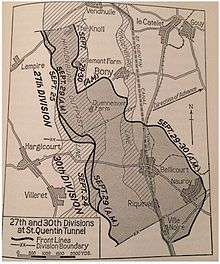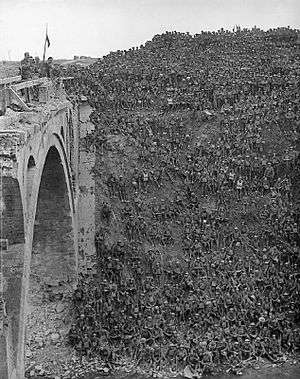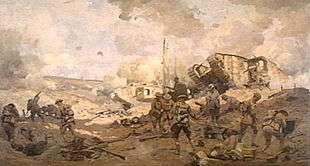Battle of St. Quentin Canal
| ||||||||||||||||||||||||||

The Battle of St Quentin Canal was a pivotal battle of World War I that began on 29 September 1918 and involved British, Australian and American forces in the spearhead attack and as a single combined force against the German Siegfried Stellung of the Hindenburg Line. Under the command of Australian general Sir John Monash, the assault achieved all its objectives, resulting in the first full breach of the Hindenburg Line, in the face of heavy German resistance and, in concert with other attacks of the Great Offensive along the length of the line, convinced the German high command that there was little hope of an ultimate German victory.
Prelude
After the German Spring Offensive, British, Commonwealth, French and American counterattacks during the Hundred Days Offensive brought the Allies back up against the outposts of the Hindenburg Line close to the village of Bellicourt by the Autumn of 1918 where the Battle of Épehy was fought on 18 September 1918.
American forces were ordered to attack on 27 September, to finish clearing German forces from outposts in front of the line. However, due to a shortage of American officers (there were only 18 officers in the 12 attacking companies – the remainder were absent receiving further training), the attack was unsuccessful. As a consequence 200 Australian Officers were then assigned to the US troops to provide both experience and leadership. As a result of the confusion created by this attack (with the corps command being unsure of where the American troops were), the attack on 29 September had to be started without the customary (and highly effective) artillery support – this was to have a large negative effect on the initial operations of the battle.
Battle

The British high command had fully realised that any success against the formidable defences of the Hindenburg Line could only be achieved with the use of tanks.
On 29 September, the Australian Corps attacked, this time with the addition of two American divisions from the American II Corps (the US 27th and 30th Divisions), supported by approximately 150 tanks of the 4th and 5th Tank Brigades (including the newly trained American 301st Heavy Tank Battalion). The US divisions launched the initial attack, with the Australian 3rd and 5th Divisions intended to "leapfrog" through the American forces. The 30th Infantry Division broke through the Hindenburg Line on 29 September 1918 at Bellicourt winning the praise of General Pershing "... the 30th Division did especially well. It broke through the Hindenburg Line on its entire front and took Bellicourt and part of Nauroy by noon of the 29th."[3]

The British 46th Division crossed the St Quentin Canal (defended by fortified machine gun positions), capturing 4,200 German prisoners (out of a total for the army of 5,300). Men of the 1/6th Battalion, the North Staffordshire Regiment, led by Captain A. H. Charlton, seized the Riqueval Bridge over the canal on 29 September before the Germans could fire the explosive charges.[4]
On 2 October, the British 46th and 32nd Divisions, supported by the Australian 2nd Division, planned to capture the Beaurevoir Line (the third line of defences of the Hindenburg Line), the village of Beaurevoir and the heights overlooking the Beaurevoir Line. While the attack succeeded in widening the breach in the Beaurevoir Line, it was unable to seize the high ground further on. However, by 2 October, the attack had resulted in a 17 km breach in the Hindenburg Line. By any measure, and especially by World War I standards, it was a stunning and swift victory.
Continuing attacks from 3 to 10 October (including those by the Australian 2nd Division capturing Montbrehain on 5 October and the British 25th Division capturing the village of Beaurevoir on 5/6 October) managed to clear the fortified villages behind the Beaurevoir Line, and capture the heights overlooking the Beaurevoir Line – resulting in a total break in the Hindenburg Line.
Notes and references
- ↑ "The Battles of the Hindenburg Line". The Long, Long Trail. Retrieved 7 February 2015.
- ↑ Bean, Charles (1942). The Australian Imperial Force in France during the Allied Offensive, 1918. Official History of Australia in the War of 1914–1918. Volume VI (1st ed.). Canberra, Australian Capital Territory: Australian War Memorial. pp. 984, 985, 986, 995, 1008, 1013 and 1027. OCLC 41008291. lists the following German divisions facing the attack: 54th, 121st, 185th, 75th Reserve, 21st, 2nd Guards, 2nd, 119th, 241st, 54th, 24th, 8th and 21st Reserve divisions. Note: this list is incomplete, as it does not include the forces facing the Allies after 5 October.
- ↑ Pershing, John J., My Experiences In The World War. Volume II, Frederick A. Stokes Company, 1931, p. 304.
- ↑ The London Gazette: (Supplement) no. 31583. p. 12221. 3 October 1919. Retrieved 7 August 2013.
External links
| Wikimedia Commons has media related to Battle of St. Quentin Canal. |
- Military History Encyclopedia on the Web – Battle of Cambrai-St. Quentin
- C.E.W. Bean, Volume VI – The Australian Imperial Force in France during the Allied Offensive, 1918 (1st edition, 1942)

